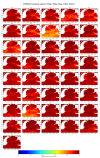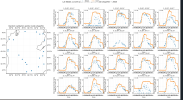What version of the code are you using?
I am running CLM5 to simulate rainfed corn, soybean, and potato. I have encountered a few issues that I would appreciate your guidance on:
Any advice or references would be greatly appreciated.



- CTSM Version: alpha-ctsm5.2.mksrf.23_ctsm5.1.dev171
- Resolution: 0.05° over Lower Michigan
- Compset: IHISTCLM50_BGC_Crop
- Meterological Forcing: CONUS404
I am running CLM5 to simulate rainfed corn, soybean, and potato. I have encountered a few issues that I would appreciate your guidance on:
- Rainfed Corn Yield Underestimation
The simulated rainfed corn yield tends to be underestimated after the year 2000. I have examined some key variables—such as BTRAN2, which suggests that water stress is not the cause (more than 0.7 in many random location in the growing period)—and also reviewed the phenology, which appears consistent with satellite-derived LAI (i.e., no phenology mismatch). I have attached examples for several representative locations. Could you please suggest additional diagnostics or possible reasons for this post-2000 underestimation? - Potato Crop Activation
I noticed that potato is listed as inactive in CLM5. Could you please provide guidance or documentation on how to activate or parameterize this crop type for simulation?
Any advice or references would be greatly appreciated.



